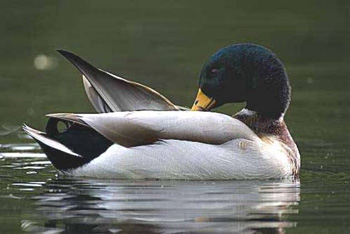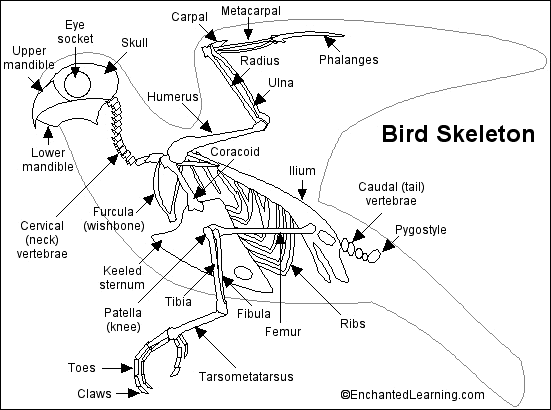Visit this page to view our Creature Feature, where we showcase an example of New Zealand's extraordinary wildlife.
Mallard duck
Mallard ducks in New Zealand: mallard are common wild ducks that live in Northern Hemisphere wetlands.

Most domestic (tame) ducks were bred from mallards. The female is called a hen, the male is called a drake, and the young are called ducklings.
In New Zealand, introduced mallards are mating with the native grey duck. During the past 80 years, mallards have been released to supplement wild duck populations, and the proportion of grey ducks remaining is only about five percent.
Mallards are waterfowl and so are most likely found on shallow bodies of fresh water such as wetlands and ponds, on lakes and even flooded fields.
What do mallard ducks look like?
The mallard is a medium-to-large dabbling duck that is most recognizable by the male's glossy green head and white collar around the neck. The female is a mottled brown with a brown bill, and both sexes have orange feet and a purple-blue speculum with both sides outlined in white. Both male and female mallards are about 20-23 inches (51-59 cm) long.
Do they fly?
Yes, and they can accomplish some interesting feats. They swim with their tail held above the water and, when they're alarmed, they spring directly out of the water and into the air. The sudden flight of mallards can make quite a spectacular sight.
How do mallard ducks feed?
By "dabbling" and upending, meaning that they tip their bodies into water, bill first, tail in the air, to forage for food. Their diet is 90% vegetarian, consisting mainly of seeds of grasses, sedges, pond weeds and other aquatic vegetation. Snails, insects and small fish sometimes are taken as well.
Do mallards have bones?
Mallards have an internal skeleton like you and me and grow by adding material to this skeleton and to their muscles.
 A bird's bones are much lighter than ours - birds have honeycomb bones so that they are not too heavy to fly. You can see all the bones in a bird’s skeleton in this picture and what their bones are called. Do any have the same names as your bones?
A bird's bones are much lighter than ours - birds have honeycomb bones so that they are not too heavy to fly. You can see all the bones in a bird’s skeleton in this picture and what their bones are called. Do any have the same names as your bones?
How do mallards raise their young?
Once Mallards arrive where they want to nest in the spring, the females build down-lined nests on the ground near lakes and reservoirs. It is important that the nests be well-placed in dense vegetation to avoid being found and eaten by predators.
Although mallards usually mate with a single bird for a particular season, the male deserts the female after only the first week of incubation. The female incubates the five to 14 eggs by herself until they hatch some time between March and July, some 26 to 30 days later. The downy young leave the nest soon after hatching and can fly from 49 to 60 days later.
What do mallards do each day?
They feed in the early morning and late afternoon – often in nearby harvested fields - returning to water after feeding. During summer, mallards spend much time asleep on water banks.
The mallard has only three defenses - swimming, flying and camouflage, and it is prey to large mammals.
How do mallards communicate?
The hen (female) mallard duck produces a quack, while the drake (male) produces a low grunt-whistle. The range of calls produced by a hen and drake mallard, as with most waterfowl, are somewhat limited. Often the same call is used in a variety of situations. For example, a simple hen mallard quack can communicate contentment, loneliness or danger. The calls produced by mallard ducks can also be used to coordinate flight when preparing for migration, leaving the roost for feeding grounds or escaping potential life-threatening situations. Mallards will also give pre-flight calls to one another to signal their intent to change.
Do mallards like to be together?
Yes, they are extremely social and gregarious creatures. They love to be part of the crowd. During migration, mallards will congregate in huge numbers at key staging and refuge areas as they travel through the different flyways. Many of these key areas will hold tens of thousands if not hundreds of thousands of mallard ducks at one time.
When viewing a flock or group of contented mallards you may notice many of the following characteristics. In many instances you will notice ducks tipping up and down as they feed, wings being flapped and stretched and splashing as they chase each other around.
Most members of the group will have a low profile contented head position. Low profile head positions are those of dabbling, resting, preening, sleeping or contented ducks. There will always be some members of the flock that have upright heads to watch for danger. The more upright heads that are in the group, the more wary and alert the group is to danger.
Do mallards moult?
Most ducks, including mallard ducks, undergo two body moults each year, which means they lose many of their feathers. During mid summer into early autumn their plumage is very drab and basic. As the autumn and winter progress hormonal and dietary changes cause the plumage to become a brilliant breeding or alternate plumage.
Caring for this plumage is of the utmost importance. Feathers are composed primarily of keratin, the same substance that comprises our finger nails and hair. Frequent preening and bathing are vital to the health of the feathers. While preening the mallard duck squeezes oil from a gland at the base of their tail onto their bill and methodically spreads it across their plumage.
Since mallard ducks can't reach their heads and necks with their bills, they rub oil on them from their bodies and then work the feathers back into place with their feet. Regular bathing helps to cleanse the plumage of dirt, debris, and external parasites.